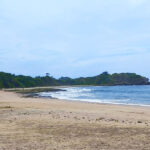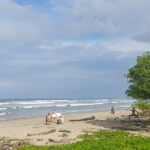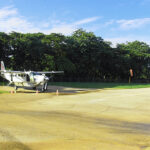Service 24/7/365
info@gypsycabnosara.com
Phone: + (506) 8302-1903
info@gypsycabnosara.com
- About
- Contact
- Publications
- LIR Airport – Nosara
- SJO Airport – Nosara
- Other Services
- My account
- Cart
- About
- Contact
- Publications
- LIR Airport – Nosara
- SJO Airport – Nosara
- Other Services
- My account
- Cart
What Makes a Beach Good for Surfing?

Surfing is a thrilling sport that requires a combination of skill, timing, and the right conditions. To answer the question, “what makes a beach good for surfing,” we’ll dive into the various factors that influence wave quality, weather, and the overall surfing experience.
Conditions for Good Surfing
Ideal Swell
The best swell for surfing is typically a groundswell, which is generated by distant storms and travels across the ocean, resulting in clean, organized, and powerful waves. Swells from different directions can also create a variety of wave shapes and sizes, allowing surfers to find the perfect wave to ride.
Wave Type
Surfers generally prefer clean, well-formed waves with a smooth face and a peeling break, allowing them to ride along the wave for a longer time. A wave’s shape and power can vary depending on the type of break it forms over, such as a beach break, reef break, or point break.
Tides
Tides play a crucial role in surf conditions, with some breaks working better at high tide and others at low tide. The best time to surf will depend on the specific spot and the way the tide interacts with the local underwater topography.
Weather
Weather conditions also significantly impact the quality of the surf. Offshore winds create clean and well-shaped waves, while onshore winds can lead to choppy and disorganized surf. Additionally, certain weather patterns can result in more significant swells and better waves.
Choosing a Good Surf Spot
Location
When looking for a good surf spot, consider the type of break, the consistency of waves, and accessibility. Popular surf destinations often have consistent waves and a variety of breaks to accommodate different skill levels.
Break Type
The type of break will affect the wave’s shape, speed, and power. Some surfers prefer the powerful, barreling waves of a reef break, while others may prefer the more forgiving waves of a beach break. Choose a spot with a break type that suits your skill level and preferences.
Crowds
Popular surf spots can get crowded, leading to competition for waves and potentially dangerous situations. When choosing a surf spot, consider the crowd size and the vibe in the lineup. Less crowded spots may provide a more enjoyable and relaxed surfing experience.
Types of Surf
There are four primary types of surf breaks:
- Beach breaks – Waves break over a sandy bottom, creating a more forgiving and less predictable environment, making it suitable for beginners.
- Reef breaks – Waves break over a coral or rocky bottom, producing powerful and consistent waves, often favored by more experienced surfers.
- Point breaks – Waves wrap around a point or headland, creating long and peeling waves ideal for carving and longboarding.
- Rivermouth breaks – Waves form where a river meets the ocean, generating sandbars and unique wave shapes.
Wave Selection and Riding
Picking the Right Wave
Surfers need to develop their wave selection skills to identify the best wave to ride in a set. Factors to consider include the wave’s size, shape, and speed, as well as the surfer’s skill level and personal preferences.
Wave Size for Beginners
Beginners should start with small waves, ideally around 1.5 to 3 feet. Smaller waves are less powerful and easier to manage, allowing beginners to build their skills and confidence before attempting larger waves.
Hardest Wave to Surf
Some of the hardest waves to surf are found at locations like Teahupo’o in Tahiti, Pipeline in Hawaii, and Mavericks in California. These waves are known for their power, size, and challenging conditions, often requiring expert-level skills to ride successfully.
Surfing and Tides
High Tide vs. Low Tide
The optimal tide for surfing depends on the specific break and local topography. Some breaks work best at high tide when the water covers shallow reef or rocks, while others work best at low tide when sandbars create better wave shapes. Experimenting with different tide levels at your local spot will help you find the best conditions.
Surfing and Weather
How Weather Affects Surf
Weather plays a crucial role in surf quality. Offshore winds create clean, well-shaped waves, while onshore winds can lead to choppy and disorganized surf. Additionally, certain weather patterns, such as low-pressure systems, can result in more significant swells and better waves.
Surfing After Rain
Surfing after rain can be hazardous due to increased runoff from urban areas and agriculture, leading to poor water quality and potential health risks. It’s generally best to wait at least 48 hours after heavy rain before surfing to allow water quality to improve.
Surfing in Cold Water
Cold water surfing requires proper wetsuit gear and additional precautions to stay warm and avoid hypothermia. However, many surfers are drawn to cold water spots for the uncrowded lineups and unique wave conditions.
Surfing in the Rain
Surfing in the rain can be a fun and unique experience, but it’s essential to be aware of potential water quality issues and reduced visibility. Additionally, ensure you take extra care when entering and exiting the water, as surfaces may be slippery.
Surfing in Different Seasons
Bigger Waves in Winter
In many locations, waves are larger and more powerful in winter due to increased storm activity and stronger swells. These conditions can be ideal for experienced surfers seeking challenging waves but may be too intense for beginners.
The Surfing Lifestyle
Surfers’ Calm Demeanor
Surfers are often seen as calm and laid-back, which can be attributed to the meditative aspect of surfing and the connection with nature. Riding waves requires patience, focus, and being in tune with the ocean, which can lead to a more balanced and relaxed mindset both in and out of the water.
The Appeal of Surfing
Surfing is more than just a sport; it’s a lifestyle and a culture that many people fall in love with. The thrill of riding waves, the connection with nature, and the camaraderie among surfers make it an incredibly fulfilling and addictive pursuit.
Surfing in the Early Morning
Surfers often hit the waves early in the morning for several reasons, including lighter winds, less crowded lineups, and the peaceful atmosphere of watching the sunrise over the ocean. Early morning sessions can also provide a great start to the day, leaving surfers energized and refreshed.
When Not to Surf
Dangerous Conditions
It’s essential to know when to stay out of the water for your safety. Avoid surfing during thunderstorms, when there are strong rip currents, or when the waves are too big or powerful for your skill level.
Environmental Concerns
Surfing after heavy rainfall can lead to poor water quality due to urban and agricultural runoff. It’s best to wait at least 48 hours after rain before hitting the waves to reduce the risk of waterborne illnesses.
Factors Influencing Wave Size
Three major factors influence wave size:
- Wind – The strength, duration, and direction of the wind play a crucial role in generating swells and shaping waves.
- Swell – Swells are created by storms and travel vast distances across the ocean, resulting in the waves we see at the beach.
- Tidal Changes – Tides can impact the size and shape of waves, with some spots working better at high tide and others at low tide.
Getting Good at Surfing
Challenges
Becoming proficient at surfing takes time, dedication, and practice. The hardest parts of surfing include learning to read waves, improving balance, and mastering maneuvers on the wave face.
Age Considerations
It’s never too late to start surfing. While it may be easier for younger individuals to learn, adults can also develop their skills and enjoy the sport with proper instruction and practice.
Wave Formation and Breaking
Basic Wave Types at the Beach
There are three basic wave types at the beach:
- Spilling waves – These waves have a gentle break with white water cascading down the wave face, ideal for beginner surfers.
- Plunging waves – These waves create a hollow barrel or tube, favored by experienced surfers for their power and speed.
- Surging waves – These waves surge up the beach without breaking, typically found on steeply sloping beaches.
Why Waves Break on the Shore
Waves break on the shore due to the interaction between the wave’s energy and the ocean floor’s shape. As waves approach shallow water, their speed decreases, and their height increases, eventually causing the wave to break when the energy can no longer be supported.
Conclusion
A beach’s suitability for surfing depends on a variety of factors, including swell, wave type, tides, and weather conditions. By understanding these factors and choosing the right surf spot, surfers can maximize their enjoyment and success in the water. Ultimately, what makes a beach good for surfing is the combination of conditions that provide quality waves and a positive surfing experience.
FAQs
Why do surfers look so good?
Surfing is a physically demanding sport that provides a full-body workout, leading to a toned and athletic physique.
Can you surf 1.5-foot waves?
Yes, small waves like 1.5-foot waves can be suitable for beginners to practice their skills and build confidence before attempting larger waves.
Is wind bad for surfing?
The direction of the wind is essential for surfing. Offshore winds (blowing from the shore out to sea) create clean and well-shaped waves, while onshore winds (blowing from the sea to the shore) can lead to choppy and disorganized surf.
Why are waves stronger in winter?
In many locations, waves are larger and more powerful in winter due to increased storm activity and stronger swells.
Why can’t you surf after rain?
Surfing after heavy rain can be hazardous due to increased urban and agricultural runoff, leading to poor water quality and potential health risks. It’s generally best to wait at least 48 hours after heavy rain before surfing to allow water quality to improve.
- Nosara vs. Tamarindo: Your Ultimate Guide to Choosing the Perfect Costa Rican Destination – A Gypsy Cab Nosara Exclusive
 Embark on a picturesque journey to Nosara and Tamarindo with Gypsy Cab Nosara. Discover the tranquil beaches, vibrant surf spots, and culinary delights that await in these Costa Rican paradises. Your adventure begins here!
Embark on a picturesque journey to Nosara and Tamarindo with Gypsy Cab Nosara. Discover the tranquil beaches, vibrant surf spots, and culinary delights that await in these Costa Rican paradises. Your adventure begins here! - 10 Articles You Can Read on National Geographic About Costa Rica
 Explore the vibrant world of Costa Rica through ten insightful articles from National Geographic. Discover the country's rich biodiversity, culinary revolution, conservation efforts, and unique cultural practices.
Explore the vibrant world of Costa Rica through ten insightful articles from National Geographic. Discover the country's rich biodiversity, culinary revolution, conservation efforts, and unique cultural practices. - Costa Rica’s Journey to Independence: A Tapestry of Resilience and Unity
 Embark on a rich and vibrant journey through Costa Rica's path to independence. Discover the significant events, notable figures, and cultural narratives that have shaped this remarkable nation. Engage with the past and explore the promising road ahead, as we celebrate the spirit of 'Pura Vida' in modern Costa Rica.
Embark on a rich and vibrant journey through Costa Rica's path to independence. Discover the significant events, notable figures, and cultural narratives that have shaped this remarkable nation. Engage with the past and explore the promising road ahead, as we celebrate the spirit of 'Pura Vida' in modern Costa Rica. - Nosara vs. Santa Teresa: A Comprehensive Guide for Tourists by Gypsy Cab Nosara
 Explore the contrasting charms of Nosara and Santa Teresa with our comprehensive guide. From serene beaches to vibrant nightlife, discover which Costa Rican gem aligns with your travel dreams. Brought to you by Gypsy Cab Nosara.
Explore the contrasting charms of Nosara and Santa Teresa with our comprehensive guide. From serene beaches to vibrant nightlife, discover which Costa Rican gem aligns with your travel dreams. Brought to you by Gypsy Cab Nosara. - Introduction to Playa Guiones
 Discover the beauty and charm of Playa Guiones, a surfer's paradise nestled in Nosara, Guanacaste. Learn about its rich biodiversity, unique culture, and the range of activities and services it offers.
Discover the beauty and charm of Playa Guiones, a surfer's paradise nestled in Nosara, Guanacaste. Learn about its rich biodiversity, unique culture, and the range of activities and services it offers. - Gypsy Cab Nosara Shuttle Service to Boutique Hotel Lagarta Lodge: An In-Depth Review
 Experience the magic of Nosara with Gypsy Cab Nosara's shuttle service and discover the luxury and sustainability of the Boutique Hotel Lagarta Lodge. Dive into our in-depth review and let Costa Rica's gem captivate you
Experience the magic of Nosara with Gypsy Cab Nosara's shuttle service and discover the luxury and sustainability of the Boutique Hotel Lagarta Lodge. Dive into our in-depth review and let Costa Rica's gem captivate you - Nosara vs. Samara: A Detailed Comparison to Help You Choose Your Ideal Costa Rican Destination
 Discover the hidden gem of Costa Rica in our ultimate Nosara travel guide. Explore stunning beaches, world-class surf breaks, lush wildlife reserves, and a thriving yoga scene. Start planning your trip to Nosara today!
Discover the hidden gem of Costa Rica in our ultimate Nosara travel guide. Explore stunning beaches, world-class surf breaks, lush wildlife reserves, and a thriving yoga scene. Start planning your trip to Nosara today! - Gypsy Cab Nosara Shuttle Service to The Gilded Iguana Surf Hotel: A Comprehensive Review
 Experience the magic of Nosara with The Gilded Iguana Surf Hotel. Dive into our comprehensive review, from its rich history to modern amenities, and discover the convenience of the Gypsy Cab Nosara shuttle service from Liberia Airport.
Experience the magic of Nosara with The Gilded Iguana Surf Hotel. Dive into our comprehensive review, from its rich history to modern amenities, and discover the convenience of the Gypsy Cab Nosara shuttle service from Liberia Airport. - Your Comprehensive Guide to Flying to Nosara, Costa Rica
 Plan your trip to Nosara, Costa Rica with our comprehensive guide. Learn about flight options, airlines, booking tips, and more to ensure a smooth journey.
Plan your trip to Nosara, Costa Rica with our comprehensive guide. Learn about flight options, airlines, booking tips, and more to ensure a smooth journey. - Experience Unforgettable Beach Vacations with BeachManagementNosara
 Experience unforgettable beach vacations with Beach Management Nosara. Choose from a variety of luxurious vacation houses, each offering a unique blend of comfort, luxury, and a close connection to nature. Enjoy top-notch amenities and services, including property management, vacation rentals, and concierge services, all designed to ensure a memorable stay in Nosara, Costa Rica.
Experience unforgettable beach vacations with Beach Management Nosara. Choose from a variety of luxurious vacation houses, each offering a unique blend of comfort, luxury, and a close connection to nature. Enjoy top-notch amenities and services, including property management, vacation rentals, and concierge services, all designed to ensure a memorable stay in Nosara, Costa Rica.
- Nosara vs. Tamarindo: Your Ultimate Guide to Choosing the Perfect Costa Rican Destination – A Gypsy Cab Nosara Exclusive
- 10 Articles You Can Read on National Geographic About Costa Rica
- Costa Rica’s Journey to Independence: A Tapestry of Resilience and Unity
- Nosara vs. Santa Teresa: A Comprehensive Guide for Tourists by Gypsy Cab Nosara
- Introduction to Playa Guiones

